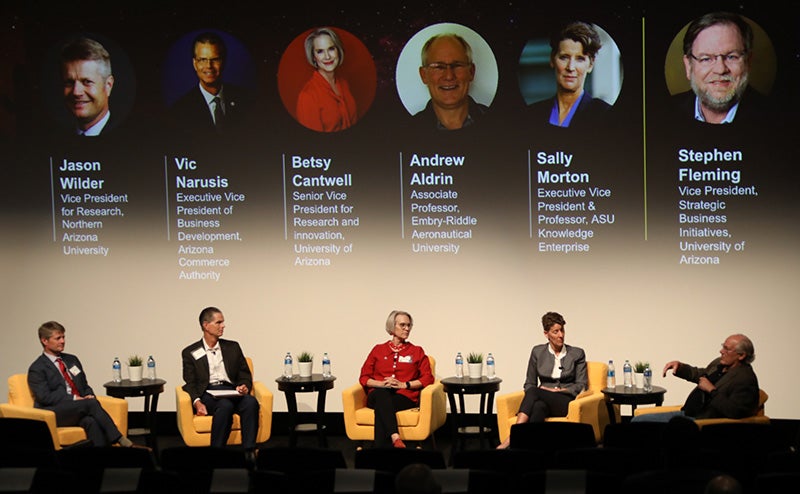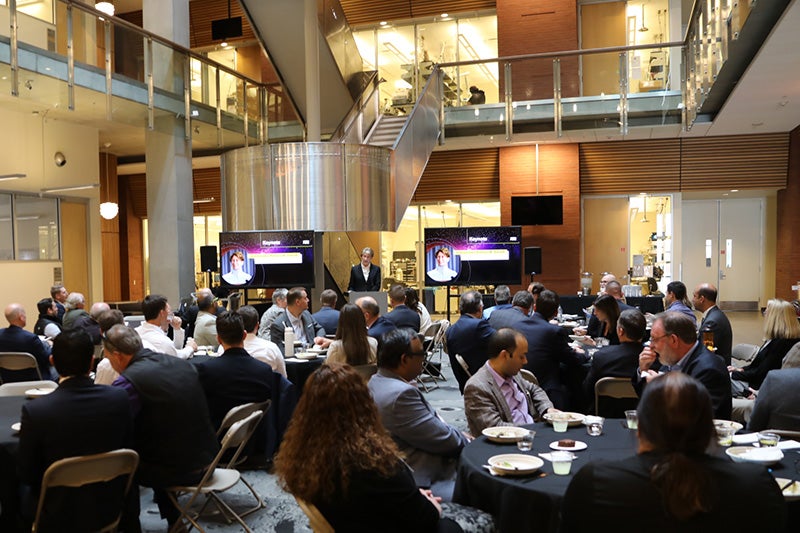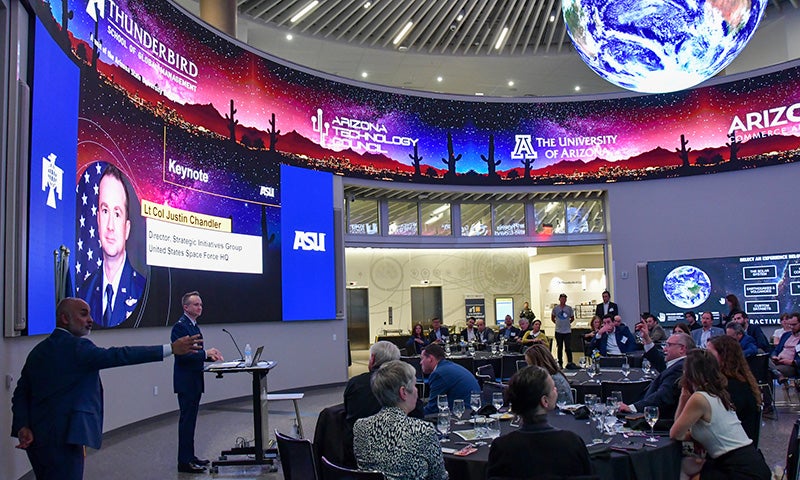ASU helps chart a course for Arizona’s space industry

Arizona State University hosted the first Arizona Space Summit, bringing together industry, academia and policymakers to support a growing space sector in the state.
According to the Big Bang Theory, a tiny speck of unimaginable energy exploded 13.8 billion years ago, creating all matter in the universe and eventually forming the galaxies, planets and stars that humans have spent the last 60 years exploring.
Arizona has been at the forefront of such exploration across our solar system and beyond. Today, the state’s space sector is poised for its own “Big Bang” of explosive expansion.
This month, Arizona State University convened industry, academia and policymakers to coordinate efforts supporting this growth at the first Arizona Space Summit.
Hosted by the ASU Interplanetary Initiative, the School of Earth and Space Exploration, ASU NewSpace, the Thunderbird School of Global Management and the Ira A. Fulton Schools of Engineering, the event included networking opportunities, panels and a reception dinner. The summit explored Arizona’s space ecosystem and its benefits to participants’ organizations, while providing opportunities to discuss what the industry needs to grow and thrive.
“Our goal with the summit was to provide participating companies with a deeper understanding of how Arizona is advancing the sector today,” said Jessica Rousset, deputy director of the Interplanetary Initiative and head of the Space Summit planning committee, “but also, to gain insights into how the state can further evolve its talent pool, infrastructure and business environment to maximize the growth of this important sector.”
Arizona is home to top engineering and space companies, including Boeing, Honeywell Aerospace and Northrop Grumman. In fact, Arizona is the fifth-largest employer in aerospace and defense manufacturing, with more than 1,250 companies contributing to its supply chain.
“We have an ecosystem that we've built here in Arizona that supports a strong sector that will last them the entire time they're here,” said Vic Narusis, executive vice president of business development at the Arizona Commerce Authority, during “The Future of Space in Arizona” session.
ASU has been involved in space research since the 1960s and assisting NASA missions since the '70s. The University of Arizona ranks fifth for NASA-funded activity and has long been at the forefront of space exploration, dating to the founding of the Lunar and Planetary Laboratory and the first Ranger missions to the moon in the 1960s. Along with the University of Arizona and Northern Arizona University, ASU is a member of the Arizona Space Grant Consortium, a coalition that encourages research, training and education in the space industry. ASU is also the only university to be an executive member of the Commercial Spaceflight Federation.
Participants at the Arizona Space Summit in the atrium of ASU’s Interdisciplinary Science and Technology Building IV. Photo by Chase Kassel
Empowering future space leaders
An astronomical component of growing the space industry in Arizona is investing in the future of space — students.
At the summit, ASU Space student ambassadors, undergraduate students who are passionate about space exploration and getting involved in the space industry, volunteered and attended sessions.
Lucas Barduson, a senior studying aerospace engineering, said the opportunity to hear the conversations going on around the space industry in Arizona was the most valuable part of his experience attending as a student ambassador.
Barduson proposes creating more opportunities for students to be involved with these conversations by coordinating all of the space-related student clubs on campus.
Additionally, a career fair hosted at the Memorial Union on April 5 allowed students to connect with space industry recruiters and learn what career options are available to them after graduation. Companies including Blue Origin, AstroForge, Katalyst Space Technologies and LinQuest Corp, among others, shared opportunities and information with interested students.
“It’s really cool to have General Dynamics Mission Systems, which is a legacy defense company, and Blue Origin, which is a new space company, talk to students together in the same room,” said Chase Kassel, a portfolio manager at the ASU Interplanetary Initiative.
For international students like Pradnesh Mhatre, who is getting his master’s degree in aerospace engineering, it can be challenging to secure jobs in the space industry in the United States. The career fair was an opportunity for him to see what options are available.
“There are many companies that just hire U.S. citizens, but there are very few companies, like Planet, which hire international students, since most of the aerospace industry comes under the defense domain,” Mhatre said.
Working together to navigate challenges
The summit opened with remarks from Lindy Elkins-Tanton, vice president of the ASU Interplanetary Initiative and principal investigator of the NASA Psyche mission; Jim Bell, director of ASU NewSpace; and Meenakshi Wadhwa, director and Foundation Professor in the School of Earth and Space Exploration; followed by recorded remarks from Arizona Gov. Katie Hobbs.
Speakers emphasized the importance of collaboration between educational institutions, economic development groups — such as the Arizona Commerce Authority, the Arizona Technology Council and the Greater Phoenix Economic Council — and industry partners to propel the state further into the commercial space sector.
“There's a tremendous amount of innovative research and education that's going on here in the planetary, astronomical and space sciences in general. It's not surprising that this amount of activity is actually having a huge economic impact already in the state of Arizona,” Wadhwa said. “The reason we are here is to see if we can scale that to an even bigger impact.”
Panelists discuss the future of space in Arizona during a session at the Arizona Space Summit. Photo by Chetan Nagaraja
In “The Future of Space in Arizona,” panelists from Arizona’s three public universities, Embry-Riddle Aeronautical University and the Arizona Commerce Authority discussed how Arizona’s leading academic institutions and government partners can financially drive the space sector in the state.
“Rocket fuel is not kerosene and oxygen, it's cash. Instead of looking at remote sensing technology, look at where business information markets are headed, because that's where the revolutions are gonna happen,” said Andrew Aldrin, associate professor at Embry-Riddle and director of the Buzz Aldrin Space Institute.
In the “Growth and Needs of the Space Industry” session, representatives from Blue Origin, Redwire Space, United Launch Alliance and Voyager Space Holdings discussed the current state of the space industry and what is needed for continued growth to allow the industry to thrive.
A key enabler of growth in the commercial space sector is reducing the cost of access to space through reusable launch vehicles, according to Kiah Erlich, head of brand partnerships and astronaut sales at Blue Origin.
“We're making space more accessible by reducing the cost of access to space, and enabling a more diverse demographic of astronauts, one that represents our demographics here on Earth. Back when I was a kid, statistically, you had about a better chance of becoming a rockstar than an astronaut,” she said.
Following this were sessions discussing how manufacturing and satellite communications companies can address the needs of the space industry, including representatives from Lunasonde, Viasat, Moog Space and Defense Group, Terran Orbital and General Dynamics Mission Systems.
"There is an insatiable demand for connectivity and we need to get more evenly distributed,” said Ken Buer, the chief technological officer of Viasat. “That will help a lot of people that don’t have access to information and don’t have access to being able to contribute in a meaningful way to science and technology in the future."
During lunch, keynote speaker Barbara Barrett, former secretary of the Air Force, gave a wide-ranging overview of Arizona’s key role in advancing space science, the space economy and national security.
Ambassador Barbara Barrett, former secretary of the U.S. Air Force, delivered the lunchtime keynote speech at ASU’s Interdisciplinary Science and Technology Building IV. Photo by Chase Kassell
“I can’t think of a more relevant keynote speaker for this event than Ambassador Barrett, who has had a remarkable leadership journey in the private, public and academic space sectors with deep roots in Arizona,” Rousset said.
In the final session, “Space Science,” speakers from Mayo Clinic, ASU and NAU focused on biomedical life sciences, space exploration and space medicine, covering topics such as pharmacogenomics, radiation protection and manufacturing in microgravity. They emphasized the need for hardware that can operate at a high level of experimental reproducibility and modularity, as well as multidisciplinary collaboration among scientists, engineers and commercial companies.
Kyle Squires, dean the Fulton Schools, opened the final session with an overview of the seven engineering schools at ASU and their space-related programs.
The event rounded out with a dinner reception at the Thunderbird School of Global Management’s new Global Headquarters on ASU’s Downtown Phoenix campus. Sanjeev Khagram, director general and dean of Thunderbird, discussed Thunderbird’s Initiative for Space Leadership, Policy and Business and its work to bring space sector leaders together to address global challenges and drive collaboration in commercial space and beyond.
Several state legislators attended the event, which included a keynote speech from Lt. Col. Justin Chandler, the director of the chief of space operations’ Strategic Initiatives Group of the U.S. Space Force, and special recorded remarks from U.S. Sen. Mark Kelly.
Lt. Col. Justin Chandler of the U.S. Space Force takes a question during the Arizona Space Summit reception at ASU’s Thunderbird School of Global Management. Photo by Terrance Balousek
“Our nation needs groups like this to work together to solve these complex problems we face today and will continue to face in the future,” Chandler said. “This effort will require all of us.”
Building on the success of the inaugural summit, the planning committee is working to establish it as an annual event. To keep the momentum going in the meantime, they will release a report of key insights in the coming weeks.
“This is a great example of us working all together across the state to showcase the assets we have, and then to build on the connections that we make,” Rousset said. “We will continue to grow the Arizona space ecosystem and support an industry that will carry humanity forward in unprecedented ways.”
More Science and technology

ASU and Deca Technologies selected to lead $100M SHIELD USA project to strengthen U.S. semiconductor packaging capabilities
The National Institute of Standards and Technology — part of the U.S. Department of Commerce — announced today that it plans to…

From food crops to cancer clinics: Lessons in extermination resistance
Just as crop-devouring insects evolve to resist pesticides, cancer cells can increase their lethality by developing resistance to…

ASU professor wins NIH Director’s New Innovator Award for research linking gene function to brain structure
Life experiences alter us in many ways, including how we act and our mental and physical health. What we go through can even…



